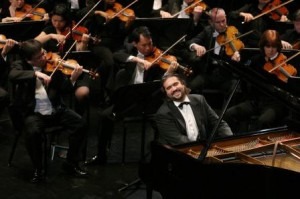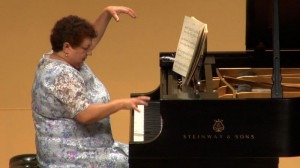
Davide Cabassi (age 28, Italy) performing with the Fort Worth Symphony in the Van Cliburn International Piano Competition
Credit: J.W. Pepper
My colleagues and I go through mountains of music. Our concentration, our emotions and our physiological abilities are taxed to the limit and we push our bodies physically sometimes to the breaking point. We agonize over every note and every phrase. We analyze each nuance to attain the ultimate interpretation of the music at hand. I’ve always thought this was essential for music-making, that is until I had the privilege of experiencing the Magic of Amateurs.
Each year for the last sixty years, hundreds of avid chamber music aficionados from far and wide have gathered for intensive chamber music playing at the Chamber Music Conference and Composer’s Forum of the East in Bennington, Vermont. These are amateur musicians, many of whom are quite accomplished players, who ultimately chose other careers and whose great passion in life is to make music.
Not a moment is wasted. They eagerly race from building to building and room to room, instruments in hand, choosing from the vast library of chamber music on hand arranged alphabetically, in large Tupperware containers spread across a huge hallway organized by size and instrumentation of the group—virtually everything for two to 10 players. The musicians read music from morning until night with nary a breath taken.
As guest faculty and lecturer I was invited to present my injury prevention seminar—Playing (Less) Hurt, coaching individuals who may have technical issues or issues of discomfort. I also was to post my “dance card” allowing the attendees to sign up to play chamber music with me. “Sure,” I’d said, “I’d be happy to play a few things.…” after all I too am passionate about chamber music. Little did I know what was in store for me.

They Came To Play
Credit: American Public Television
Initially, I must admit, I tried to grab the cello parts surreptitiously ahead of time (although no one else did.) “I have to practice this,” I thought, a bit disconcerted. My head began to whirl. “I don’t do this. I don’t play without preparation. I should put in a few fingerings and bowings at least. It would be unthinkable to fudge parts of this difficult piano quintet….” And any time of the day was open game. Again I reeled. “What? Play through the Schubert Quintet for two cellos at midnight?”
I was totally unprepared for what I encountered. The Bennington attendees’ vast knowledge of the literature was humbling, as they had played through much of the music time after time, year after year. They could pontificate about the composers and argue the finer points of interpretation, having availed themselves of every opportunity to compare various recordings.
Some of the players were quite accomplished and some not. But even so, there was only one rule: once the piece was started no one stopped for any stragglers or errors— no apologies accepted or needed. I couldn’t help being caught up in their sweeping joy of music making and after a few days I too was able to let go of my inhibitions about playing “unprepared.” I bit my tongue if I missed a note, stifling the “sorry” I might have uttered out of force of habit. (We professionals are always sorry if we make even the tiniest of errors.) I was able to savor the wonderful music, the collegiality and the friendships that ensued. Sight-reading music, volumes of it, was fun, revelatory.
There are countless amateur ensembles in the country—everything from full orchestras to bands, from chamber music ensembles to singing groups from Bluegrass to Scottish pipe bands. Many of these musicians dedicate their precious free time on the weekends or evenings to practice and rehearse. Their dedication is infectious. Music making has many benefits. Playing music increases memory and learning, enhances coordination, improves reading, teaches discipline and increases comprehension and best of all, the camaraderie can’t be beat. Studies indicate that playing a musical instrument at any age tones the brain.
There are more than 62 million amateur musicians in the U.S. indicating that one in five people play a musical instrument. The American Chamber Music Players society ACMP, has 5,400 members. In the United Kingdom, the UK Amateur Orchestras organization has a huge number of non-professional orchestras and the World Federation of Amateur Orchestras lists a dizzying number of organizations globally.
I have been fortunate enough to be featured as soloist with several amateur orchestras in the concertos of Schumann, Dvorak, Haydn and Elgar. The musicians were thrilled to be playing with a pro—someone they might learn from and be inspired by. The accompaniments are difficult and sometimes the rehearsals felt like playing in quicksand but the groups always rallied and they played better than they thought they could. The experience each time was exhilarating for all of us.
There have been amateur instrumentalists even 200,000 years ago. Kings and queens, doctors and lawyers, farmers and teachers pursue playing an instrument and singing in a chorus for the sheer love of music. Thanks for the eye-opening reminder that making music is truly magical.
Kristin Anderson
2012 Cliburn Amateur Piano Video Contest Winner


